Discuss Notion Music Composition Software here.
5 posts
Page 1 of 1
|
Here's an interesting Notion challenge. Wondering if any of the folks here have an idea how to handle this unusual instruction for piano:
"press down keys without the hammers striking the strings" I think I know what the composer is asking for, but how on earth do I get a computer to do that?
iMac (Retina 5K 27", 2019) 3.6 ghz I9 8-core 64 gb RAM Fusion Drive
with small AOC monitor for additional display macOS Sonoma 14.4 2 - 500 gb + 2 - 1 tb external SSD for sample libraries M Audio AirHub audio interface Nektar Panorama P1 control surface Nektar Impact 49-key MIDI keyboard Focal CMS40 near-field monitors JBL LSR310S subwoofer Notion 6/Notion Mobile + Studio One 6 Pro http://www.tensivity.com |
michaelmyers1 wroteHere's an interesting Notion challenge. Wondering if any of the folks here have an idea how to handle this unusual instruction for piano: If the sustain pedal is pressed (also confusingly called the "damper" pedal), then the dampers for all the strings are lifted away from the strings, and the strings then can vibrate unimpeded, which includes sympathetic vibrating . . . As you know, tone, texture, and timbre come from harmonics and overtones, where (a) harmonics are integer number multiples and (b) overtones are real number multiples, hence include harmonics . . . Some of this might be difficult to perceive, but since any single note on a piano spans multiple frequencies as the consequence of harmonics and overtones, when the sustain pedal is activated, playing one note will cause some sympathetic vibrating on other strings, which mathematically wanders at some point into Eigenvalues . . . Intuitively, the only explanation of the composer's instructions that comes to mind is that the goal is to use the mechanism of individual notes to provide selective sustain . . . Before a note is pressed on the piano, its respective string is damped (correct usage of the term) and prevented from vibrating sympathetically, at least to the extent this is practical . . . In a ideal scenario, the way to stop a string from vibrating is to damp the entire string along its full length, but this is not practical on a grand piano or an electric guitar . . . A damped piano string will vibrate, but its ability to vibrate is strongly constrained . . . If you delve too deeply, then you have to switch to quantum mechanics, at which time everything becomes surreal . . .
Nevertheless, one might suggest that the composer's instructions describe a curious type of piano string entanglement, where the technique establishes the conditions necessary for notes or vibrating strings to interact in very specifically defined ways . . . For example, consider Bass A (A2 in scientific pitch notation) at standard tuning ("Concert A" = 440-Hz), which will have the fundamental or root frequency 110-Hz as a pure sine wave . . . There also will be harmonics and overtones, and one of the overtones will be the frequency of the fifth (E3 in scientific pitch notation), which depending on the way the piano is tuned (well-tempered, equal-tempered, and so forth) will be approximately 164.81-Hz . . . When the sustain pedal is pressed and all the strings can ring or vibrate freely, playing a Bass A note will cause the E3 string to vibrate a little bit . . . Based on the hypothesis that this sympathetic vibrating of the E3 string causes it to act as a Helmholtz resonator, the energy required to vibrate the E3 string will be expended or absorbed, and the consequence will be that the E3 component of the Bass A will be absorbed, hence will not be heard so prominently . . . If you take an empty Coca-Cola bottle and add water to the bottle until the note that happens when you blow across the top of the bottle is E3, then (a) this is a simple Helmholtz resonator and (b) it will absorb some of the sonic energy of the E3 note . . . [NOTE: It probably needs to be a large Coca-Cola bottle, perhaps a 3-liter bottle, although perhaps an even larger bottle . . . ] Putting this into perspective, given the following parameters, this is a Helmholt resonator at 82,887-Hz, which is near E3 and is a somewhat oddly shaped, very large Coca-Cola bottle:
[SOURCE: Helmholtz Resonator Calculator] 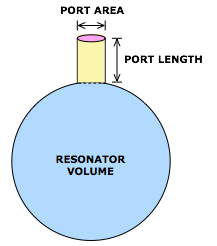 Helmholtz Resonator [NOTE: The Greeks and Romans used Helmholtz resonators in their theaters to control the acoustic behaviors of the space. Specifically, they embedded large wine bottles in the walls horizontally and filled the bottles with varying amounts of sand, depending on the type of program being presented to the audience in the theater. I think the bottles would be approximately the size of 5-gallon water bottles or even larger; and they probably had some smaller bottles to adjust the midrange and high-frequency acoustics, as well, although thick cloth curtains tend to work just as well for midrange and high-frequency sound absorption. And it's useful to know that a simple gypsum board wall is a set of Helmholtz resonating panels, which if you drill a small diameter hole in the various sections then become Helmholtz resonators. I included this information for folks who might not know. Architects know this stuff, but not everyone is an architect or interested in this stuff. Rolls of fiberglass insulation and cubes of compressed cellulose insulation are excellent low-frequency absorbers; and I use them here in the sound isolation studio (6 rolls of fiberglass insulation and 5 cubes of compressed cellulose insulation), which controls the otherwise gnarly, deep bass standing wave. The bass response of the sound isolation studio is very crisp and punchy, which basically maps to a flat equal loudness curve in the low-frequency range. Getting a flat equal loudness curve for the midrange and high frequencies is easier, and I do it with an equalizer and real-time analyzing and calibrating software, which is fine so long as the adjustments are in the range from -3 dB to +3 dB, which minimizes distortion produced by equalizing. If it requires a greater amount of equalizing, then you need to switch to doing physical room treatments, which is the reason for the fiberglass rolls and cellulose cubes. You can use PVC pipes of varying lengths to absorb specific frequencies in a studio or listening room, where one end of the PVC pipe is closed and the other end is open. The lower the frequency, the larger diameter and longer the PVC pipe needs to be. One way to get a sense of the various PVC pipe sizes and dimensions is to look at a cathedral pipe organ . . . ] 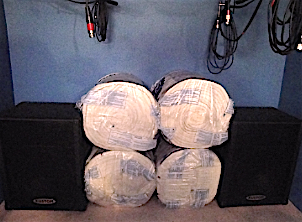  THOUGHTS (1) Based on this set of information and hypotheses, I think the only practical way to solve the problem is to create your own sampled sound library, which will require one or two microphones; a grand piano; an acoustically neutral room; recording software (DAW application); an audio wave editing application like Audacity; and a sampled sound library creation application like SampleTank 3 (IK Multimedia), although I think Kontakt 5 (Native Instruments) and MachFive 3 (MOTU) also can create sampled sound libraries from digitized notes . . . Obviously, you want to ensure the grand piano is properly tuned to standard Concert A (440-Hz) . . . (2) If you have (a) a DAW application that lets you specify the Sostenuto Pedal very precisely and (b) a sampled sound library for grand piano that fully supports the Sostenuto Pedal and is chromatically sampled, this this is another possible solution that might be practical, since it does most of what the composer described, at least in a general way . . . [NOTE: NOTION 6 does not provide the specific support for the Sostenuto Pedal that this technique requires; so you need to do this in a DAW application that provides the necessary Sostenuto Pedal actions; and the music notation needs to be done in the DAW application, which also needs to work with the required, chromatically-sampled sampled sound library for the grand piano. You can write the music notation in NOTION 6 and then export it to the DAW application; but you will need to do the Sostenuto Pedal articulations in the DAW application. I'm not so certain about multiple-voice support in DAW applications on the same staff; so this might be a problem, as well. Whether this works depends on the ability to do all this stuff in a very precise way, since it involves specific interactions among vibrating strings . . . ] Given the premise that the goal of pressing the piano keys according to the composer's instructions is to cause each individual piano key to cause its respective string to be undamped, hence to be able to vibrate sympathetically, then I think the following sequence of actions might provide a solution:
This might work, and the general idea is that the specific individually sustained notes (done via the Sostenuto Pedal) will act as analogs of Helmholta resonators and will change the overtones of the notes that are played such that the hammer hits the respective string(s) . . . (3) At least in theory, i suppose it's possible to create a custom frequency filter for each note that is analogous to the behavior of sustained piano strings for specific notes, but this is the most complex of the three strategies, and I am not convinced anyone can discern the differences when it's done with custom frequency filters . . . If the only instrument playing is a grand piano, then I think this can be heard and discerned; but if other instruments and singing is occurring simultaneously, then it's spinning wheels and is a waste of time . . . On electric guitar, this maps to having FUN with harmonics; and it's a real and tangible thing which can be heard and discerned when done properly; so depending on the circumstances, it's not spinning wheels and wasting time . . . Jimmy Page did something like this at the start of "Dazed And Confused" (Led Zeppelin); and there are other lead guitar players who do some fascinating things with harmonics . . . SUBTRACTIVE vs. ADDITIVE The way I explained this is based on the Sostenuto notes being subtractive; but they also could be additive, where instead of reducing the volume levels of certain overtones, they increase the volume levels slightly for the respective overtones . . . In practice, this is the way the Indian sitar produces its distinctive timbre . . . For grand piano, there were additional strings added to vibrate sympathetically with the idea being that the sympathetic resonance would enrich the timbre and overall loudness of certain strings . . . This is called "aliquot stringing", and it's more additive than subtractive . . . Aliquot String (Wikipedia) I have an electric sitar, and it has a set of what I call "droning strings" that look like a miniature zither . . . 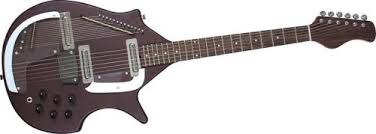 There is a separate "lipstick" pickup for the "droning" strings, which makes it possible to increase or decrease the volume level of the "droning" strings . . . For the piano technique, I tend to think it's more subtractive than additive; but another possibility is that it creates a bit of reverberation . . . The best way to determine whether it's subtractive or additive is to do some experiments on a piano--in particular when the piano has a Sostenutu Pedal, since it's easier to do with a Sostenuto Pedal, at least for experimental purposes . . . As a general rule, I think it's more likely the affect will be subtractive for higher-frequency notes and additive for lower-frequency notes, with the reason being that lower-frequency notes have more energy, hence are more likely to have sufficient energy to induce sympathetic vibrations that can be heard and discerned . . . SUMMARY (1) Additive: If the goal is to have the non-hit notes be additive, then this probably can be achieved in music notation by playing the non-hit notes on a different staff and adjusting the volume level and dynamics for that staff so that the emulated, sympathetically resonating notes are heard at volume levels which produce the desired effect . . . [NOTE: After recording the non-hit notes in a DAW application in a ReWire session, I think it makes sense to edit the resulting audio clip to remove the attack parts of the notes, which might be done just as easily by varying the volume level during the attack phases so instead of being abrupt the volume level increases gradually, which is more consistent with the way a string will start resonating sympathetically. Once you hear how it works, I think the specifics of how to fine-tune it will become obvious. To avoid confusion, the non-hit notes are played as hit notes on the sympathetic resonating staff. In the original score, according to the composer's instructions, the notes are not actually hit; but in this music notation workaround, they are just regular notes but on a separate staff, where the idea is that by actually playing the notes via music notation, this emulates the non-hit notes vibrating sympathetically; and to make this more like sympathetically vibrating strings, I think the attack and decay parts of each note or chord need to be softened significantly. If the tempo is slow and the notes or chords are longer duration, then you might be able to do this with crescendos and diminuendi . . . ] 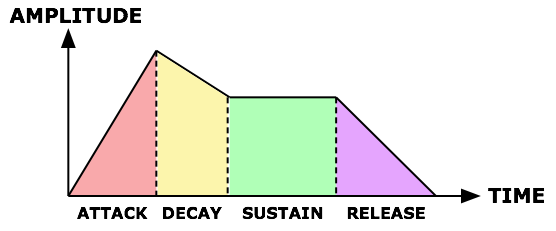 ADSR (Single Note or Chord) 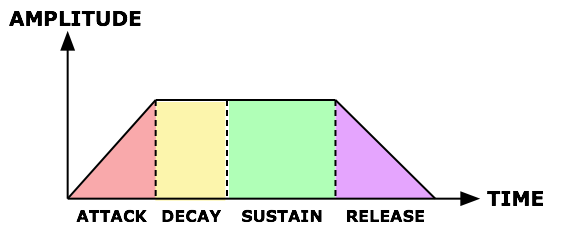 ADSR (Single Note or Chord) ~ Adjusted for Sympathetic Resonance (2) Subtractive: If the goal is subtractive, then it's not so easy to do; and in some respects the only truly practical way to do it is either (a) to hire a proficient pianist or (b) to get a good quality piano that has a Sostenuto Pedal and to play the piece yourself . . . Lots of FUN!
Surf.Whammy's YouTube Channel
The Surf Whammys Sinkhorn's Dilemma: Every paradox has at least one non-trivial solution! |
|
Surf, thanks for the encyclopedic reply as always, I thought you might be interested in this one!
Not having a grand piano or a studio in which to fit it at my disposal, I thought another approach might be to use a piano sample and modify it to reduce the volume of the initial attack or the sound of the hammers, but somehow keep the ringing of the strings. This was my interpretation of what was being asked for. Another practical solution that came to mind, for the recording at hand, is to reduce the volume of the piano at the moment of the attack and to then increase it so that the ringing of the strings is heard but not the hammer. Haven't had time to implement either, and of course I will have to leave my Notion comfort zone to do this. Stay tuned! Michael
iMac (Retina 5K 27", 2019) 3.6 ghz I9 8-core 64 gb RAM Fusion Drive
with small AOC monitor for additional display macOS Sonoma 14.4 2 - 500 gb + 2 - 1 tb external SSD for sample libraries M Audio AirHub audio interface Nektar Panorama P1 control surface Nektar Impact 49-key MIDI keyboard Focal CMS40 near-field monitors JBL LSR310S subwoofer Notion 6/Notion Mobile + Studio One 6 Pro http://www.tensivity.com |
|
I don't have a piano that has a sostenuto pedal, but I did some experiments on a good quality piano that has three pedals: (a) pianissimo pedal, (b) bass sustain pedal, and (c) full-range sustain pedal, (left, center, right, respectively) . . .
[NOTE: The sustain pedal raises the string dampers off the strings, and for this reason it's also called a "damper pedal", which makes a bit of sense, except that it doesn't "damper"; so it's like using "D" for "park" and "P" for "drive" on a car, but so what . . . ] I think the composer's instruction is designed to be a DIY sostenuto pedal, since it's at least part of what the sostenuto pedal does (as best as I can determine) . . . My intuitive expectation is that if I play a C4 major triad (C4, E4, G4) and press the sostenuto pedal while the respective C4 major triad keys are pressed, then the dampers for the three notes will continue to be lifted off the respective strings for as long as the sostenuto pedal is pressed . . . Intuitively, I also think this means I don't need to continue holding the three piano keys down, since the sostenuto pedal now is doing this automagically . . . If this is the way it works, then I should be able to play other notes and they will be played as usual without pedal-controlled sustain . . . I also think I should be able to play any or all of the three C4 major triad keys to cause additional string hits, but without activating the respective dampers, since with the sostenuto pedal pressed continually, the respective dampers continue to be lifted . . . Whether it works this way is another matter . . . Regardless, pressing and holding piano keys in such a way that there is no actual string hit and only the respective dampers are lifted should be similar to or perhaps exactly what the sostenuto pedal does . . . I think this is an advanced technique, and it's intriguing . . . THOUGHTS Based on what I have read about aliquot strings, I'm guessing that the non-hit notes are played with the right hand and held with their respective dampers lifted off the strings, while the hit notes are played with the left hand and are lower relative to the right-hand keys . . . I can do some experiments this way, and it might be sufficient to make sense of the technique . . . Lots of FUN!
Surf.Whammy's YouTube Channel
The Surf Whammys Sinkhorn's Dilemma: Every paradox has at least one non-trivial solution! |
|
Hello.
The VSTI by Modart -Pianoteq along with some newer hardware MIDI keyboards and tone generators provide "Sympathetic resonance". Here's an paragraph from the Pianoteq 5 User manual.
The Sympathetic resonance parameter controls the weight of the strings’ sympathetic resonances. It is used, for example, in the famous piece Mikrokosmos by Béla Bartók. The sympathetic resonances depend on the position of each individual damper, and consequently on the position of the sustain pedal: it is longer when the sustain pedal is down, for dampers do not then touch the strings. Experiment by pressing down a few keys very slowly so that they do not produce any sound, and then, without pressing down the sustain pedal, play a few notes staccato. You will hear the resonance introduced into the first depressed notes. If you release these notes, the sound will stop. You can also do the “opposite” experiment. Play a note loudly and hold it, press silently another note, and release the first note: it continues resonating in the second note. Also, I haven't tried it yet in a DAW but a feature of the latest VST3 instrument standard is that it can include audio input from an external sound source in order to simulate the sympathetic resonant affect caused by other instrument sounds. Giving the affect of stage presents and feedback when among the proximity of other virtual instrument sounds. And, other possible effects and control from combining the input of other sound sources. The Notion mixer does not have audio input so that type of VST3 instrument feature is not possible at present version. ,Newberry |
5 posts
Page 1 of 1
Who is online
Users browsing this forum: No registered users and 10 guests


